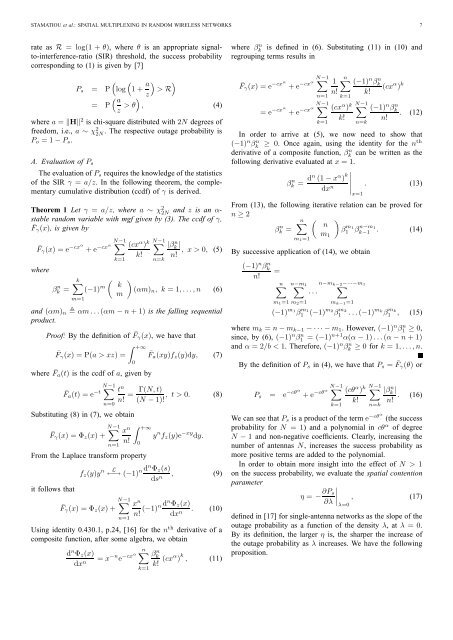channel - Advances in Electronics and Telecommunications
channel - Advances in Electronics and Telecommunications
channel - Advances in Electronics and Telecommunications
Create successful ePaper yourself
Turn your PDF publications into a flip-book with our unique Google optimized e-Paper software.
STAMATIOU et al.: SPATIAL MULTIPLEXING IN RANDOM WIRELESS NETWORKS 7<br />
rate as R = log(1 + θ), where θ is an appropriate signalto-<strong>in</strong>terference-ratio<br />
(SIR) threshold, the success probability<br />
correspond<strong>in</strong>g to (1) is given by [7]<br />
� �<br />
Ps = P log 1 + a<br />
� �<br />
> R<br />
� z<br />
a<br />
�<br />
= P > θ , (4)<br />
z<br />
where a = �H�2 is chi-square distributed with 2N degrees of<br />
freedom, i.e., a ∼ χ2 2N . The respective outage probability is<br />
Po = 1 − Ps.<br />
A. Evaluation of Ps<br />
The evaluation of Ps requires the knowledge of the statistics<br />
of the SIR γ = a/z. In the follow<strong>in</strong>g theorem, the complementary<br />
cumulative distribution (ccdf) of γ is derived.<br />
Theorem 1 Let γ = a/z, where a ∼ χ2 2N <strong>and</strong> z is an αstable<br />
r<strong>and</strong>om variable with mgf given by (3). The ccdf of γ,<br />
¯Fγ(x), is given by<br />
¯Fγ(x) = e −cxα<br />
+ e −cxα<br />
where<br />
β n k =<br />
k�<br />
m=1<br />
N−1 �<br />
k=1<br />
(−1) m<br />
�<br />
k<br />
m<br />
(cx α ) k<br />
k!<br />
N−1 �<br />
n=k<br />
|βn k |<br />
, x > 0, (5)<br />
n!<br />
�<br />
(αm)n, k = 1, . . . , n (6)<br />
<strong>and</strong> (αm)n � αm . . . (αm − n + 1) is the fall<strong>in</strong>g sequential<br />
product.<br />
Proof: By the def<strong>in</strong>ition of ¯ Fγ(x), we have that<br />
¯Fγ(x) = P(a > xz) =<br />
� +∞<br />
where ¯ Fa(t) is the ccdf of a, given by<br />
0<br />
¯Fa(xy)fz(y)dy, (7)<br />
¯Fa(t) = e −t<br />
N−1 � tn Γ(N, t)<br />
= , t > 0. (8)<br />
n! (N − 1)!<br />
n=0<br />
Substitut<strong>in</strong>g (8) <strong>in</strong> (7), we obta<strong>in</strong><br />
N−1 �<br />
¯Fγ(x)<br />
x<br />
= Φz(x) +<br />
n<br />
n!<br />
n=1<br />
� +∞<br />
From the Laplace transform property<br />
it follows that<br />
0<br />
y n fz(y)e −xy dy.<br />
fz(y)y n L<br />
←→ (−1) n dn Φz(s)<br />
ds n , (9)<br />
N−1 �<br />
¯Fγ(x) = Φz(x) +<br />
n=1<br />
x n<br />
n! (−1)n dn Φz(x)<br />
dx n . (10)<br />
Us<strong>in</strong>g identity 0.430.1, p.24, [16] for the nth derivative of a<br />
composite function, after some algebra, we obta<strong>in</strong><br />
dnΦz(x) dxn = x−ne −cxα<br />
n� βn k<br />
k! (cxα ) k , (11)<br />
k=1<br />
where βn k is def<strong>in</strong>ed <strong>in</strong> (6). Substitut<strong>in</strong>g (11) <strong>in</strong> (10) <strong>and</strong><br />
regroup<strong>in</strong>g terms results <strong>in</strong><br />
¯Fγ(x) = e −cxα<br />
+ e −cxα<br />
N−1 �<br />
n=1<br />
N−1<br />
1<br />
n!<br />
n�<br />
k=1<br />
= e −cxα<br />
+ e −cxα<br />
� (cxα ) k<br />
k!<br />
k=1<br />
(−1) n β n k<br />
k!<br />
N−1 �<br />
n=k<br />
(cx α ) k<br />
(−1) n β n k<br />
n!<br />
. (12)<br />
In order to arrive at (5), we now need to show that<br />
(−1) nβn k ≥ 0. Once aga<strong>in</strong>, us<strong>in</strong>g the identity for the nth<br />
derivative of a composite function, βn k can be written as the<br />
follow<strong>in</strong>g derivative evaluated at x = 1.<br />
β n k = dn (1 − xα ) k<br />
dxn �<br />
�<br />
�<br />
� . (13)<br />
� x=1<br />
From (13), the follow<strong>in</strong>g iterative relation can be proved for<br />
n ≥ 2<br />
β n k =<br />
n�<br />
�<br />
n<br />
�<br />
β m1<br />
1 βn−m1<br />
k−1 . (14)<br />
m1=1<br />
m1<br />
By successive application of (14), we obta<strong>in</strong><br />
(−1) n β n k<br />
n!<br />
=<br />
n�<br />
n−m1 �<br />
m1=1 m2=1<br />
n−mk−2−···−m1 �<br />
· · ·<br />
mk−1=1<br />
(−1) m1 β m1<br />
1 (−1) m2 β m2<br />
1 . . . (−1) mk β mk<br />
1 , (15)<br />
where mk = n − mk−1 − · · · − m1. However, (−1) nβn 1 ≥ 0,<br />
s<strong>in</strong>ce, by (6), (−1) nβn 1 = (−1)n+1α(α − 1) . . . (α − n + 1)<br />
<strong>and</strong> α = 2/b < 1. Therefore, (−1) nβn k ≥ 0 for k = 1, . . . , n.<br />
By the def<strong>in</strong>ition of Ps <strong>in</strong> (4), we have that Ps = ¯ Fγ(θ) or<br />
Ps = e −cθα<br />
+ e −cθα<br />
N−1 �<br />
k=1<br />
(cθ α ) k<br />
k!<br />
N−1 �<br />
n=k<br />
|βn k |<br />
. (16)<br />
n!<br />
We can see that Ps is a product of the term e−cθα (the success<br />
probability for N = 1) <strong>and</strong> a polynomial <strong>in</strong> cθα of degree<br />
N − 1 <strong>and</strong> non-negative coefficients. Clearly, <strong>in</strong>creas<strong>in</strong>g the<br />
number of antennas N, <strong>in</strong>creases the success probability as<br />
more positive terms are added to the polynomial.<br />
In order to obta<strong>in</strong> more <strong>in</strong>sight <strong>in</strong>to the effect of N > 1<br />
on the success probability, we evaluate the spatial contention<br />
parameter<br />
η = − ∂Ps<br />
�<br />
�<br />
� , (17)<br />
∂λ<br />
� λ=0<br />
def<strong>in</strong>ed <strong>in</strong> [17] for s<strong>in</strong>gle-antenna networks as the slope of the<br />
outage probability as a function of the density λ, at λ = 0.<br />
By its def<strong>in</strong>ition, the larger η is, the sharper the <strong>in</strong>crease of<br />
the outage probability as λ <strong>in</strong>creases. We have the follow<strong>in</strong>g<br />
proposition.







